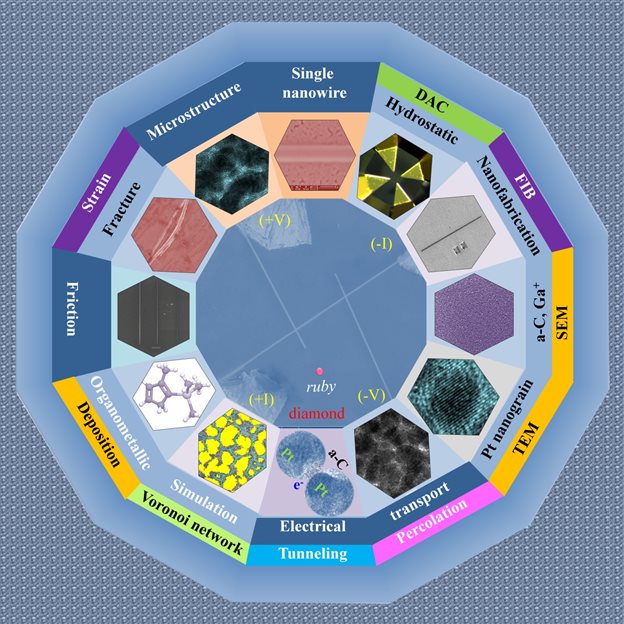A single nanowire under compression- Drs. Sudeshna Samanta & Lin Wang
FEBRUARY 4, 2019
In the January 24, 2019, issue of the journal Nano Research, a team of researchers led by Dr. Sudeshna Samanta from HPSTAR reported a new progress in a single nanowire composite using high pressure techniques to unravel the electrical transportation evolution. They found strong nonlinear electrical conductivity in compressed single Pt-C nanowire which corresponds to a pressure induced quantum phenomenon.
Nanowires can be used for transistors which are widely used in today's electronic circuits. At these scales, quantum mechanical effects are important. How external pressure will work on the quantum-scaled single nonowire composite is the focus of this study.
“Even very low pressure can trigger a dramatic change in the electrical resistivity when a system dimension becomes comparable to quantum”, said Dr. Lin Wang, the principal investigator of the work. “Pressure has a unique ability to tune the electron interactions in a clean way,” he added. “It is a direct and effective mean for tuning the behavior of electrons and could lead to the realization of potential pressure sensors.”
By using diamond anvil cell technology, the research team led by Dr. Sudeshna Samanta measured pressure-dependent electrical resistivity of a single, Pt-C nanowire composite, a form of metallic nanocrystalline platinum-amorphous carbon fabricated by focused-ion induced deposition, up to 5 GPa.

The researchers found that when a single Pt-C composite nanowire was subjected to such conditions, it underwent two sharp resistivity transitions with three separate distinct regimes—nonlinear electrical conductivity. First, the resistance increased slowly with pressure and then the nanowire appeared to be a semiconductor followed by a reversible transition during decompression.
“This kind of electrical transportation variation in a nanowire composite cannot be understood or explained using classical physics”, said Dr. Sudeshna Samanta.
“For the untreated Pt-C nanowire composite, the carbon prevents the Pt nanograins from merging and later, pressure compelled them to connect continuously as investigated by transmission electron microscopy further.”
“The nonlinear conductivity evolution within a binary component model can be best described in terms of the so-called percolation theory and tunneling effect”, said Dr. Sudeshna Samanta. “The percolation threshold denotes that the composite becomes conductive, and the tunneling effect is a quantum phenomenon where electrons pass through a barrier”. Below the percolation threshold, metallic Pt nanograins were well separated, electrons scattered from disorders, and system appeared semiconducting. Upon the coalesce of metallic grains under compression, the tunneling conductance dominated, and finally a continuum metallic path formed by the overlapping of metallic nanograins. We believe that a classical percolation and a quantum tunneling boundaries existed together; and the pressure induced conduction process handed over from a percolation to a percolation-assisted tunneling in the Pt-C nanowire”, explained Dr. Sudeshna Samanta.
They also explored the pressure-induced microstructural evolution with a series of cross-sectional HRTEM analysis. At low pressure, the isolated platinum grains moved closer. Upon further compression, the isolated platinum grains overlapped and became indistinguishable, allowing the current to pass in the shortest path and thus resulting in high conductivity in a continuum percolating metal network. Their further Voronoi network simulation also support the conduction mechanism from the HRTEM results.
